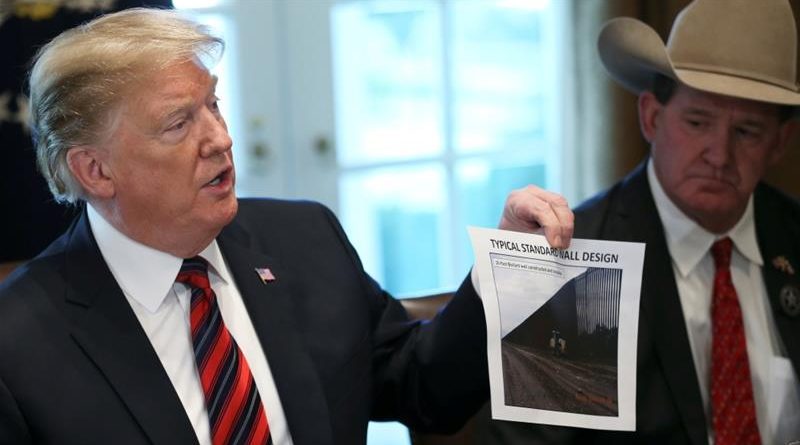U.S. Declares National Emergency
President Trump Continues To Push For Border Wall Construction
Background
On February 15th, United States President Donald Trump declared a national emergency at the US-Mexico border. After years of talk about the border wall, weeks of bickering over funding, and the longest government shutdown in U.S. history, it comes as no surprise.
In the spending bill for the next fiscal year, President Trump initially demanded US $5.7 billion to be set aside for the construction of the border wall. Democrats offered US $1.3 billion instead. This disagreement led to the government shutdown back in December.
The shutdown ended when President Trump signed the US $1.3 billion plan. However, he would not give up so easily, announcing in a televised statement that “We’re going to confront the national security crisis on our southern border, and we’re going to do it one way or the other.” The “way,” it now appears, is by declaring a national emergency.
What is a National Emergency?
Under the National Emergencies Act of 1976, Presidents may declare national emergencies to activate powers provided by other federal statutes. They would be constrained to specific powers pre-determined by law, but could act more efficiently to resolve pressing issues. National emergencies have previously been declared by Barack Obama during the 2009 swine flu outbreak and by George W. Bush in the aftermath of 9/11.
In this case, emergency status enables President Trump to redirect funds toward border wall construction. White House officials have announced, for instance, that $2.5 billion would be taken from the Department of Defense’s counter-drug activities and $3.5 billion from other military construction accounts.
Constitutional Backlash
The Act is ambiguous in its lack of specification of what constitutes an emergency. Consequently, there has been controversy over whether the declaration is even legal. Despite President Trump’s assertion that there is “an invasion of drugs and criminals coming into the country,” there has been no recent change in situations that may necessitate urgent actions. Furthermore, the issue of illegal immigration has never been labelled as an “emergency” while Congress was Republican-controlled. With a now Democrat-controlled Congress, however, it is more difficult for President Trump to get his way—the government shutdown has proved that already.
The emergency declaration thus seems thus like a shortcut to avoid opposition—and a not-so-discreet one, either. Democrats have accused him of abusing his authority. “This is plainly a power grab by a disappointed president, who has gone outside the bounds of the law to try to get what he failed to achieve in the constitutional legislative process,” said Speaker Nancy Pelosi and Senator Chuck Schumer in a joint statement. Some Republicans have also objected, as they believe the declaration would set a poor precedent that future Democrat presidents may use to justify pushing for radical policies.
Revoking the Declaration
When a national emergency is declared, Congress may pass a joint resolution to override the declaration—and on Tuesday, February 26th, they did just that. The vote was 245-182, with 13 Republicans siding with the Democrats. The resolution will now go to the Senate, where it is likely to pass again. The next step, however, asks for President Trump’s own signature, and he has already promised to veto the resolution should it get to him. After that, Congress gets a final chance to revoke it with at least two-thirds of members’ votes in both chambers, which will prove difficult.
As of now, McConnell says the Senate will likely vote on the resolution sometime before the next Senate recess, in the week of March 18th.
Bibliography:
Baker, Peter. “Trump Declares a National Emergency, and Provokes a Constitutional Clash.” The New York Times, 15 Feb. 2019. NYTimes.com, https://www.nytimes.com/2019/02/15/us/politics/national-emergency-trump.html.
CNN, Clare Foran and Alex Rogers. “House Passes Resolution to Overturn Trump’s Emergency Declaration on Border Wall.” CNN, https://www.cnn.com/2019/02/26/politics/house-vote-trump-national-emergency/index.html. Accessed 27 Feb. 2019.
National Emergencies Act, Sections 201 and 301 Fact Sheet | State Public Health | ASTHO. http://www.astho.org/Programs/Preparedness/Public-Health-Emergency-Law/Emergency-Authority-and-Immunity-Toolkit/National-Emergencies-Act,-Sections-201-and-301-Fact-Sheet/. Accessed 27 Feb. 2019.
Stewart, Emily. “Trump Just Declared a National Emergency at the Border.” Vox, 15 Feb. 2019, https://www.vox.com/policy-and-politics/2019/2/15/18173813/trump-national-emergency-border-wall-speech.
Steward, Emily. “Why Trump Thinks a National Emergency Will Get Him His Border Wall.” Vox, 8 Jan. 2019, https://www.vox.com/policy-and-politics/2019/1/8/18172749/trump-national-emergency-government-shutdown-wall.
https://www.aljazeera.com/mritems/imagecache/mbdxxlarge/mritems/Images/2019/1/11/9119c8a52de84c57aa9de94c87706e41_18.jpg

